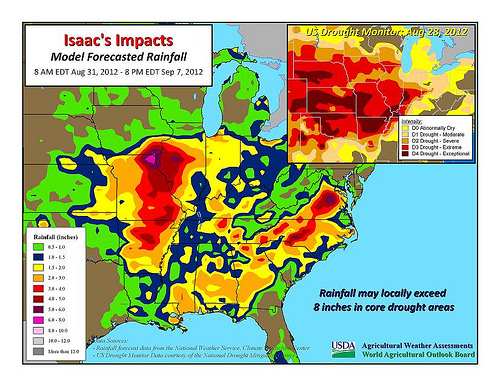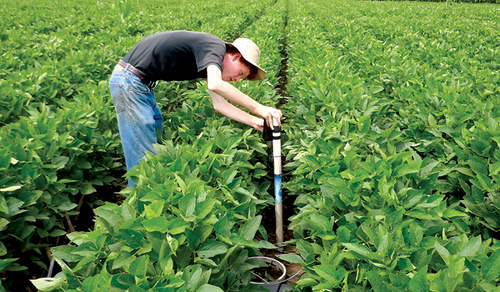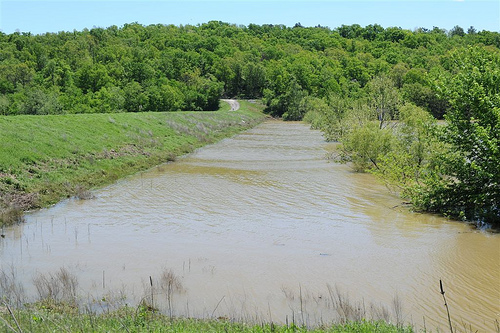
Buck Mountain precipitation gage with solar panel, radio stand, and electronics—Whitewater Baldy Complex Fire, N.M.
New Mexico experienced in June two catastrophic wildfires—the Whitewater Baldy Complex Fire and the Little Bear Fire. One consequence of those fires has been flash flooding. Water runs off more quickly during rainstorms in areas where fires have stripped the landscape. These floods can happen with very little notice, endangering communities downstream. Read more »

Isaac's Impacts: Model Forecasted Rainfall, August 31, 2012. Click to enlarge image.
Visit www.usda.gov/drought for the latest information regarding USDA’s Drought Disaster response and assistance.
Hurricane Isaac has grabbed most of the weather headlines in recent days, but drought remains deeply entrenched across nearly two-thirds of the continental United States. According to the latest U.S. Drought Monitor, dated August 28, drought covered 62.9% of the Lower 48 states, down only slightly from a peak of 63.9% on July 24. However, during the five-week period from July 24 to August 28, the portion of the country in exceptional drought (D4) increased from 2.4 to 6.0%. Read more »

NIFA-funded grad student checks soil moisture gauge.
This post is part of the Science Tuesday feature series on the USDA blog. Check back each week as we showcase stories and news from USDA’s rich science and research profile.
Over the past decade, we’ve seen a lot of variability in the weather, with severe droughts in some places, excessive flooding in others, and more extreme weather events all over the country. While there has always been variability in the weather, scientists predict increasing variability in weather patterns as the concentration of greenhouse gases (GHG) increases in the atmosphere. Such changes present challenges for farmers, who, in many areas, are trying to grow crops under hotter, drier climate regimes and must protect their crops from damage during extreme weather events. That’s why the USDA is actively doing research on how to produce crops and livestock through increasing climate variability, and that’s why the fourth in a series of Office of the Chief Scientist white papers on the Department’s research portfolio is focused on what USDA science is doing to help prepare the agency, and the nation’s farmers for a changing climate. Read more »

Prairie Grove dam helps reduce flooding of Muddy Fork Creek along the western edge of Prairie Grove.
The flooding from this year’s spring rain storms caused millions of dollars worth of damage to homes, businesses and crops in Arkansas.
But some flooding was reduced or minimized, thanks to 207 small and medium-sized dams built by USDA’s Natural Resources Conservation Service (NRCS), in partnership with local watershed districts. Read more »

U.S. Historical Marker for Methodist church in Swan Quarter.
Back in 1876, the Methodists of the coastal community of Swan Quarter, NC were keenly aware of flooding issues from heavy rain and high tides. As a result, they sought property less prone to flooding for a new church. But their efforts to purchase a specific vacant lot on high ground were unsuccessful, so the church was built near the heart of the town on a lower lot. Read more »
These past months have brought tough times for folks across the nation. Unusual weather patterns – too much water in some places, not enough elsewhere – have driven thousands of Americans from their homes, and threatened their livelihoods.
Other families have seen their lives turned upside down by tornados or threatened by historic wildfires.
In these difficult times, my heart goes out to all of those who have been touched by these disasters. And I want folks to know that at USDA – and across the federal government – we are we are doing our best to serve all those who have been affected. Read more »





